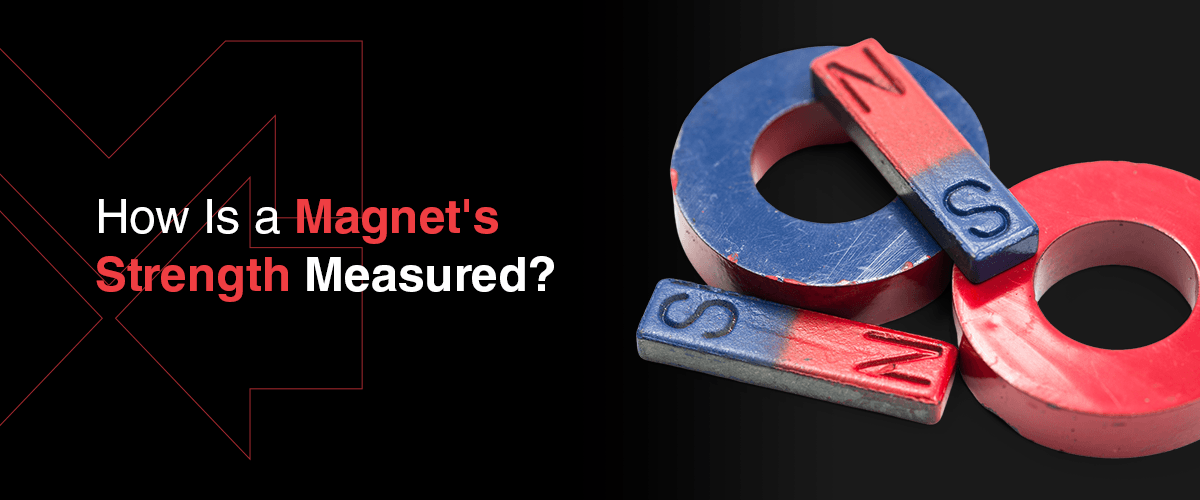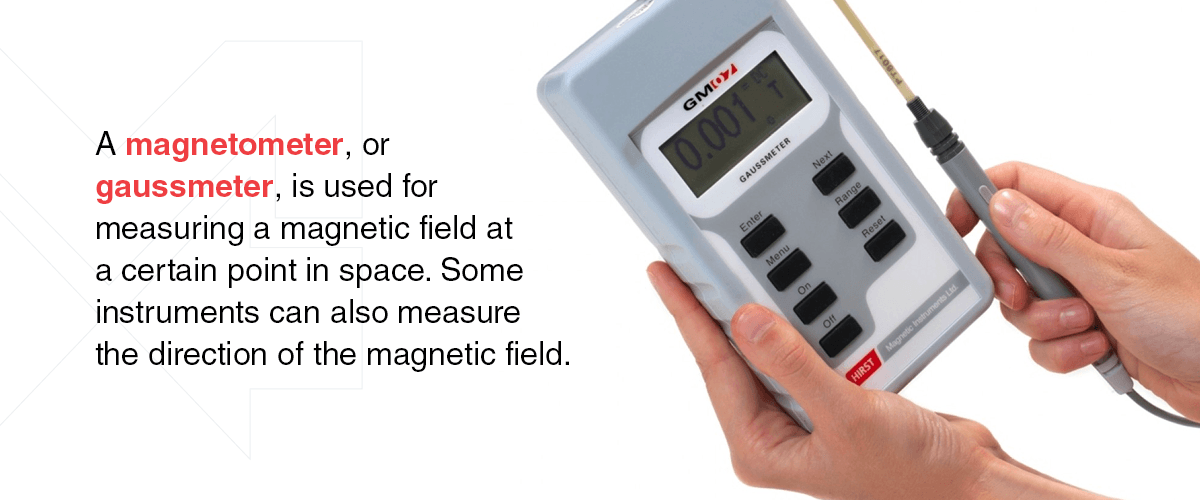
How to Measure Magnet Strength?
If your business uses magnetic products, you know how important it is for those products to be strong and reliable. However, you may not know exactly what strength means in terms of magnetic properties.
What determines the strength of a magnet, and what should you look for? This guide discusses measuring magnetic strength and what different magnet strengths mean about their usefulness in various applications.

The Different Units Used to Measure Magnetic Strength
Magnet field strength is measured in a few different forms that depend on what is most convenient for a particular application. Below are a few common units used in magnet strength measurements.
1. Tesla
The symbol T stands for the magnetic strength unit known as a tesla. It describes the density of a magnetic field, or its residual flux density.
A tesla can be described in different ways using other units of scientific measurement. For example:
T = kg / (A * s2)
where kg = kilograms, A = amperes, and s = seconds.
A tesla can also be defined in several other ways. These are just a few examples:
T = V * s / m2 or T = (N * s)/(C * m) or T = Wb / m2
where V = volts, s = seconds, m = meters, N = newtons, C = coulombs, and Wb = webers.
2. Gauss
An external magnetic force must often be applied to make a magnet magnetic. After that external force is removed, the magnetic force remaining in the magnet is known as remanence.
A Gauss, named for the German physicist and mathematician Carl Friedrich Gauss, measures the amount of remanence in a magnet. One Gauss is the magnetic flux density that produces an electromotive force of one abvolt (10-8 volts) in one centimeter of a wire per second at right angles to a magnetic flux.
One gauss is equal to 10-4 teslas. It can also be defined as one maxwell per square centimeter or 10-4 webers per square meter.
3. Oersted
Resistance to demagnetization or coercivity is measured in Oersteds (Oe), which are named after the Danish physicist Hans Christian Oersted. Coercivity, which is also measured in Oersteds, is the force required to reduce a magnet's magnetic characteristics to zero.
The Oersted is defined as one dyne per maxwell, or 1000/4π (about 79.577) amperes per meter.
4. Kilogram
Most people know kilograms (kg) as units of measure of mass. A bunch of bananas, for example, weighs roughly 1 kilogram.
In terms of magnetism, kilograms measure magnet pull strength. So the maximum weight the magnet can attract and hold is measured in kilograms. Pull strength is defined as the force required to pull a magnet away from the flat metal surface so that it is making full surface-to-surface contact.
Methods of Measuring the Strength of a Magnet
Below are a few tools and methods commonly used to measure the strength of a magnet:

1. Magnetometer/Gaussmeter
A magnetometer, or Gaussmeter, is used for measuring a magnetic field at a certain point in space. Some instruments can also measure the direction of the magnetic field.
These instruments were invented in the mid-1800s and have evolved over the decades into accurate, precise measurement tools. Today, magnetometers are used in a tremendous variety of applications, from geographical surveys to military submarine detection to aircraft directional systems.
Different magnetometers work in different ways, using different principles and methods:
- Hall effect: Magnetometers that use the Hall effect use current to ascertain whether a magnetic field is nearby and how strong it is.
- Magneto induction effects: Magnetometers that rely on magnet induction calculate how magnetized a certain material becomes when exposed to a magnetic field.
- Magnetoresistance effects: Magnetometers that use magnetoresistance calculate an object's ability to change its electrical resistance when it becomes exposed to a magnetic field.
Magnetometers can also be broken down into two other basic types: scalar magnetometers and vector magnetometers. Scalar magnetometers are instruments such as the Overhauser effect, proton precession, and ionized gas magnetometers. They measure the scalar value of the intensity of magnetic flux. Vector magnetometers, such as search-coil, magnetoresistive, and superconducting quantum interference device (SQUID) magnetometers, measure the direction and magnitude of a magnetic field.
2. Fluxmeter
A fluxmeter differs from a magnetometer because it measures magnetic flux instead of a magnetic field. Magnetic flux is the measurement of the total magnetic field passing through a given space. If we compare magnetism to electrical conductivity, magnetic flux is analogous to electrical current, whereas a magnetic field is analogous to electrical voltage.
A fluxmeter works on the principle of Faraday's law of electromagnetic induction, which states that a voltage will be induced in a conductor when the conductor is placed between shifting magnetic fields. Generally, a fluxmeter contains a moving coil affixed between two permanent magnets. A calibration meter records the voltage change observed in the coil to determine the amount of flux present in the magnetic field.
3. Magnetic Pull Tests
Magnetic pull tests measure magnet strength by measuring pull strength. They work by using a metal test piece, usually a plate for plate magnets and a sphere for magnetic tubes.
The metal test piece is attached to the hook on a scale and pulled away from the magnet at a 90-degree angle until the magnetic force can no longer act on the metal and the magnet releases it. When the release occurs, the person conducting the test reads the magnetic pull strength in pounds off the breakaway meter on the scale.
How Strong Should a Magnet Be for Your Application?
The magnet strength you require will likely depend on your specific application. The strength of the magnet you need will also determine the type of magnet you need.
When you're assessing different magnets, you'll see that they have various grades based on Gauss and Oersted measurements. Magnet grades are usually given in units of Mega Gauss Oersteds (MGOe). The magnet's resistance to coercivity in Oersteds multiplied by its remanence in Gauss equals one MGOe.
Different magnets come in different grade ranges. High-energy flexible magnets, for instance, have lower grades, such as 1.1 or 1.6. Samarium cobalt magnets, which are much stronger, might have grades ranging from 18 to 30.
For essential commercial uses such as printing and labeling, you will likely want flexible ferrite-based magnets. These are dependable magnets that perform well for general purposes. At Magnum Magnetics, we offer quality, flexible ferrite-based magnets that give your products the magnetic strength they need while allowing them to remain appealingly thin and flexible for applications like printing.
Heavy-duty applications would likely require stronger magnets, such as samarium cobalt, alnico, or neodymium magnets. These magnets are often useful in high-heat or high-intensity applications, such as those in the automotive, aerospace, medical, food, and beverage manufacturing industries.

Order Your Flexible Magnetic Products Today
When you need flexible magnetic products for commercial applications, make Magnum Magnetics your one-stop shop.
We stock an extensive catalog of inventory, from magnetic printer paper to magnetic labeling strips to plain magnetic sheeting you can customize with your own laminates or adhesive. We are also happy to provide custom magnets or special magnetization, and we are committed to ongoing product development to give you the best-quality magnets we can.
Contact us to learn more about our flexible magnetic products.